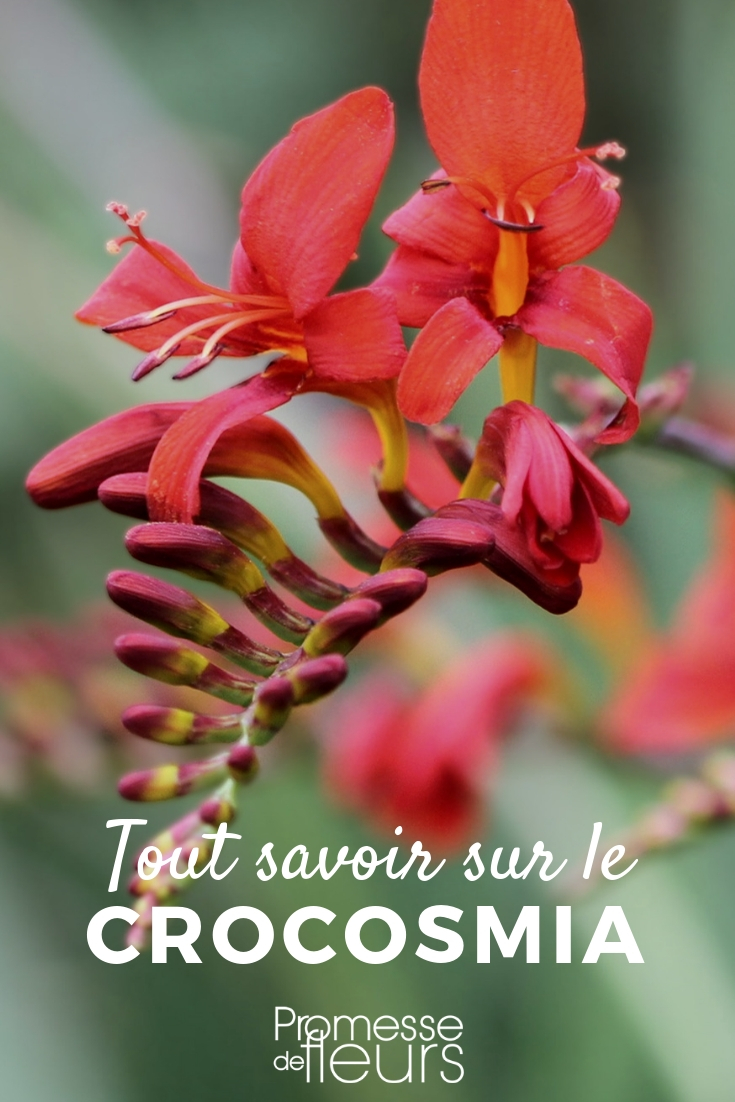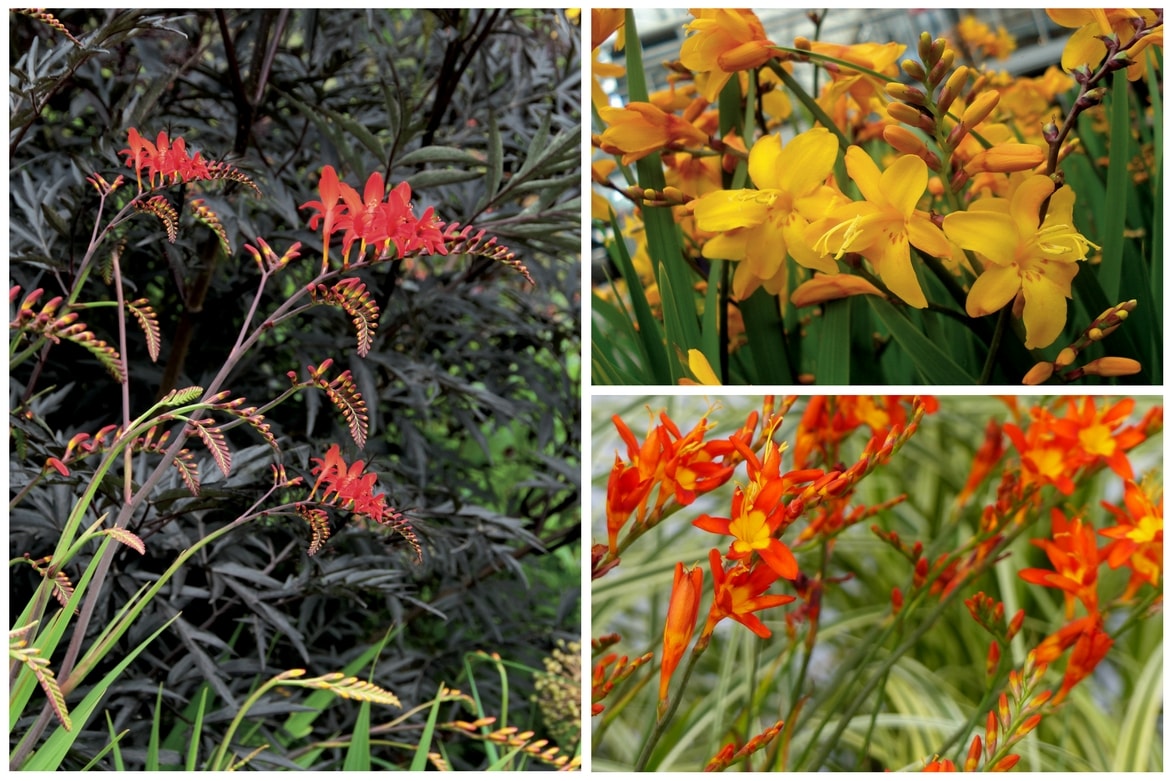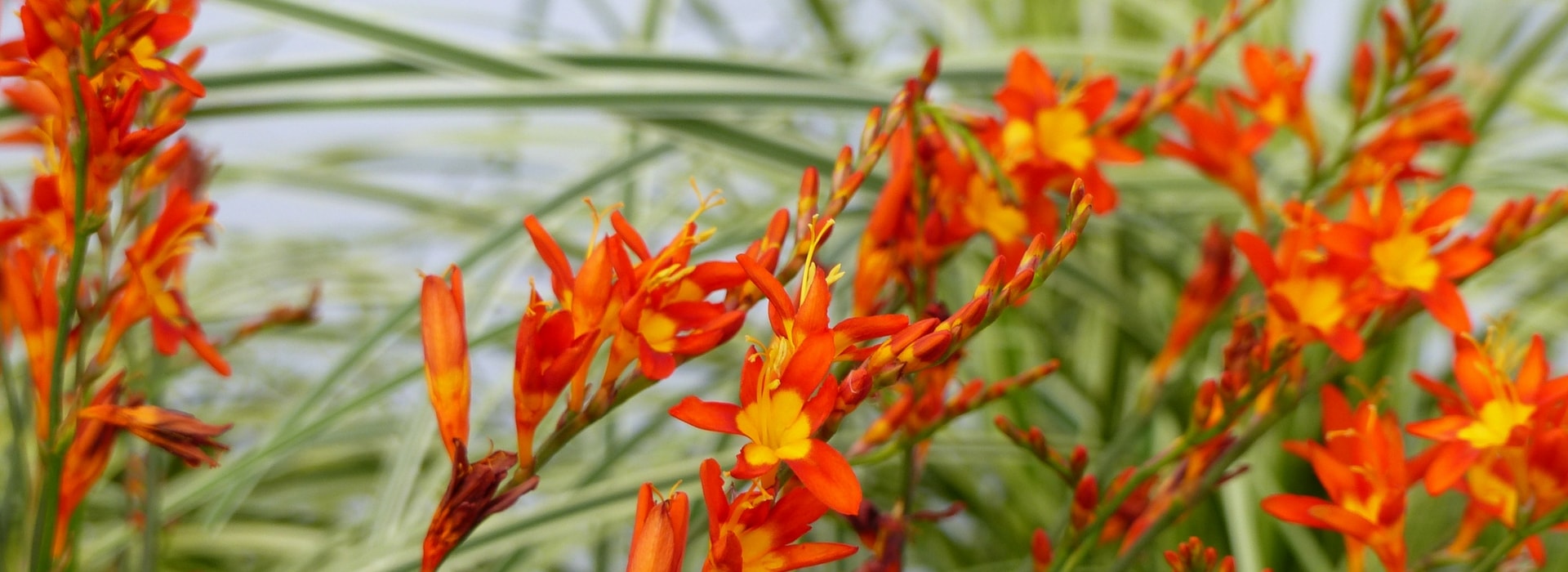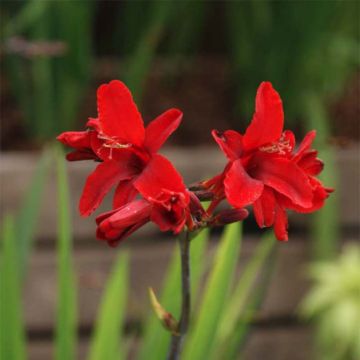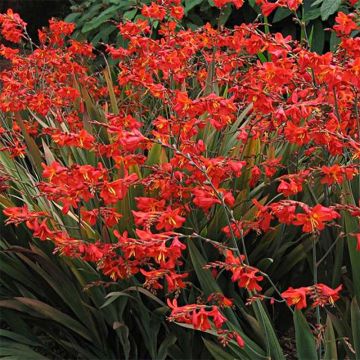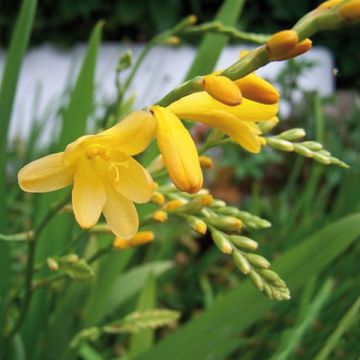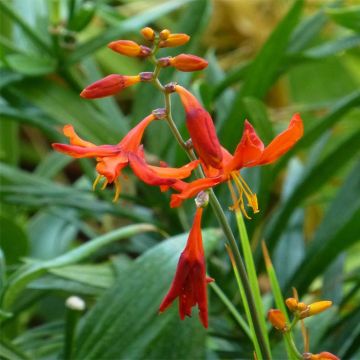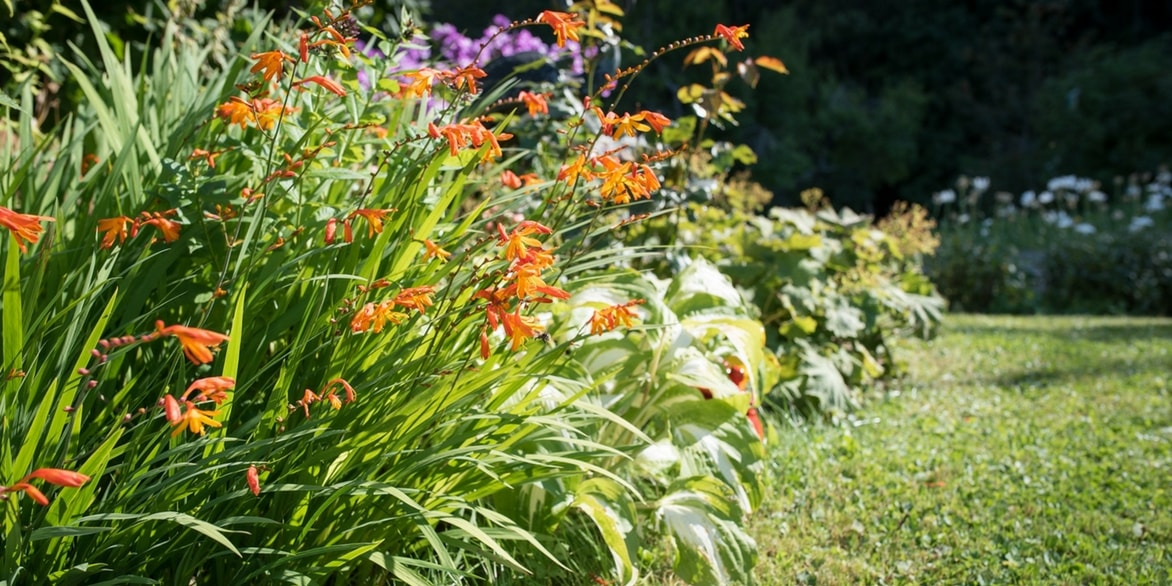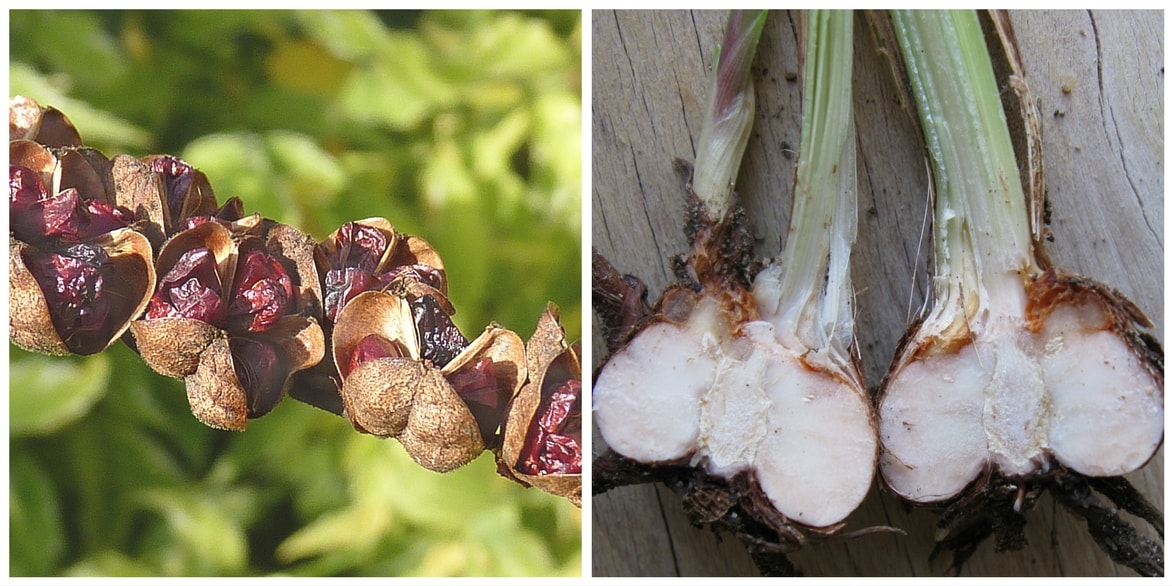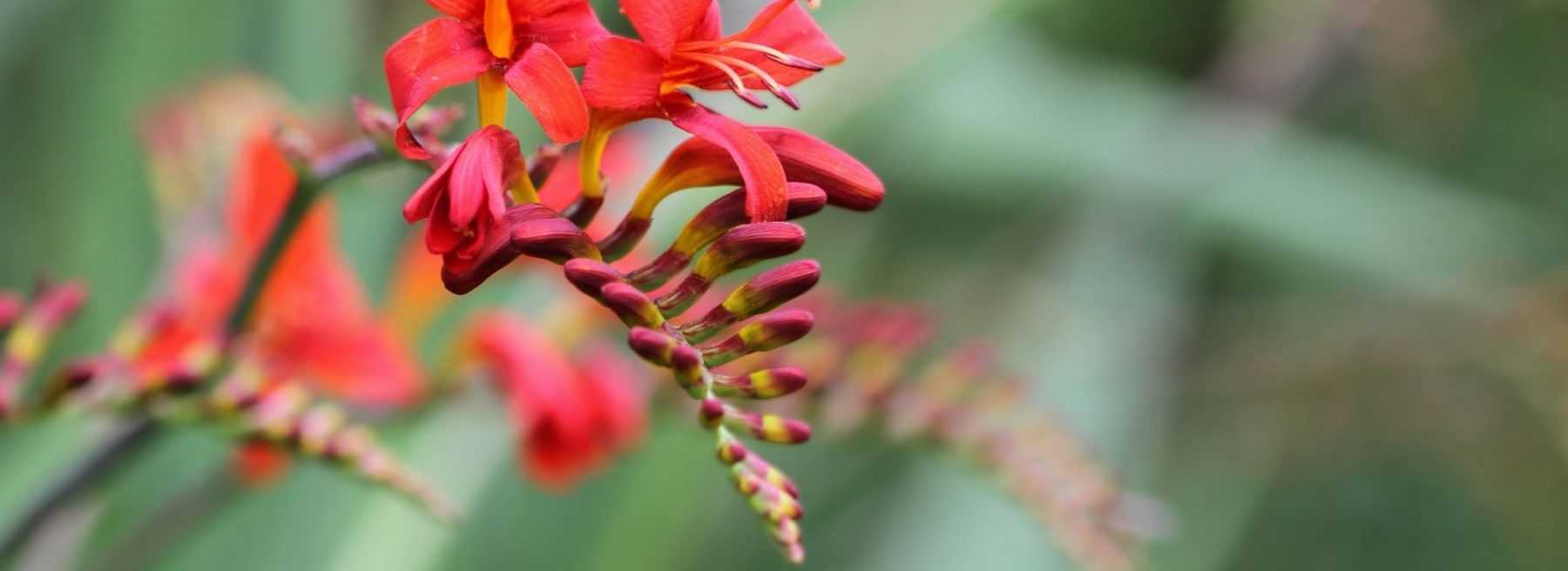
Crocosmia, Montbretia: Planting, Growing and Care
Contents
Crocosmia, in a nutshell
- With its resemblance to gladioli, Crocosmia offers a beautiful palette of warm colours: from the intense red of Crocosmia ‘Lucifer’ to the bright yellow of the ‘Columbus’ variety, not forgetting the vivid orange blooms of Crocosmia masoniorum! There are even bicoloured varieties, such as ‘Emily McKenzie’ with its orange and red flowers.
- Easy to grow and rarely troubled by diseases or pests, this flowering bulb will thrive when planted in a sunny spot with well-drained soil.
- With their intense colours and long summer flowering period, Crocosmias add an exotic and dynamic touch to sunny borders.
- Their slender, decorative foliage and architectural habit bring lightness and volume to your garden.
- Excellent as cut flowers, they are perfect for creating stunning bouquets.
Our Expert's Word
Crocosmia, or Montbretia, resembles a small gladiolus, but with its flamboyant colours, it’s a top choice for bringing dynamism and cheer to your flower beds. Crocosmia ‘Lucifer’ is undoubtedly the most popular, with its fiery red blooms. This stunning flowering bulb of South African origin will captivate you with its intensely coloured blooms and its decorative, upright, bright green foliage.
Some hybrids, such as Crocosmia x crocosmiiflora, come in a wide range of warm hues, with several hundred varieties available. You’ll easily find one to suit your taste. It’s an excellent bedding plant that pairs effortlessly with vibrant annuals or perennials for a garden bursting with colour!
Fairly easy to grow, Crocosmia mainly requires a sunny spot and well-draining soil that stays moist in summer. It’s rarely troubled by diseases or pests and requires minimal maintenance. Once established, it spreads readily by producing stolons and new bulbs. Moderately hardy, it benefits from mulching to survive winter.
It also makes a beautiful cut flower, perfect for creating bouquets. Under good conditions, it can last up to two weeks in a vase.
Botany
Botanical data
- Latin name Crocosmia sp.
- Family Iridaceae
- Common name Crocosmia or Montbretia
- Flowering July to October
- Height 60 cm to 1.20 m
- Exposure full sun, tolerates light partial shade
- Soil type moist, well-drained
- Hardiness -5°C to -10°C depending on species, down to -15°C for Crocosmia masoniorum
Crocosmias grow wild in grasslands along the eastern coast of South Africa. There are nine species, all native to South Africa except one, Crocosmia ambongensis, which is endemic to Madagascar. Horticulturists have created over 400 varieties of Crocosmia.
This plant gets its name from the Greek krokos: saffron, and osme: smell, because when the flowers are placed in warm water, they emit a strong saffron scent. Crocosmias are often known by the common name Montbretia, which more specifically refers to hybrid Crocosmias, particularly Crocosmia x crocosmiiflora.
Crocosmia belongs to the large Iridaceae family, which includes 1,800 species of mostly herbaceous plants. This cosmopolitan family (found on all continents) also includes Gladioli and Irises. These are typically geophytic plants, disappearing in autumn to overwinter underground thanks to storage organs (bulbs, corms…).
They reappear in spring. Crocosmia is very close to Tritonia, a genus that was formerly used as a synonym for Crocosmia.
Montbretia has an upright habit and forms clumps. It grows quickly and typically reaches 60 cm in height. The tallest varieties, like ‘Lucifer’, can even grow up to 1.20 m! It spreads easily via stolons, small horizontal stems that root upon contact with the soil to form new clumps. However, you’ll need patience for your plant to form a dense clump.
At the centre of the clump rise long, arching flower spikes, bearing terminal inflorescences composed of about twenty flowers. These are tubular, arranged horizontally in two rows. They come in shades ranging from intense red (‘Lucifer’) to yellow (‘George Davison’ or ‘Columbus’), through various orange hues. Some varieties, like ‘Emily McKenzie’, are even bicoloured.
Crocosmia offers a long summer flowering, from July until September-October. The flower measures about 3 cm in diameter and 2.5 cm long. It consists of six petals arranged in two rows (three inner and three outer). At the centre emerge three large stamens, all of equal length. These flowers are nectar-rich and attract butterflies.
It has very beautiful deep green leaves, upright and elongated in a lance shape. These leaves are arranged alternately on the stem (one after another). They resemble those of gladioli, also being long and pleated lengthwise. They can grow up to a metre long and 3 cm wide. The foliage is deciduous: it dies back in autumn and reappears in spring.
In autumn, to survive the winter, the plant forms corms, rounded and flattened bulb-like structures. These allow the plant to store reserves and regrow in spring. It’s a swollen stem, protected by small scales.
These corms grow in chains, one above another. There can be about ten in succession. New corms are at the top while older ones are buried deeper. Below the lowest corms, the plant has roots that allow it to anchor slightly deeper. The corms separate easily from each other, facilitating the plant’s spread (each corm can form a new plant).
Crocosmia’s fruits consist of three-lobed capsules, up to 1 cm long. They contain small brown seeds. They are decorative with their graphic appearance, resembling beads attached to the stems.
Montbretias are moderately hardy. Some very resistant varieties (like Crocosmia masoniorum) can withstand temperatures down to -15°C. But on average, they tolerate -10°C if protected by mulch. We recommend taking action in autumn to protect the bulbs by applying a thick layer of dead leaves, for example, or by digging them up to store them over winter.
The variety Crocosmia x crocosmiiflora is a hybrid created around 1880 by French nurseryman Victor Lemoine, by crossing Crocosmia aurea and Crocosmia pottsii. Cultivated worldwide, this hybrid has become invasive in California, New Zealand, the UK, Australia, Réunion…
Crocosmia thrives in maritime climates, quite mild and humid. In France, it does well along the Atlantic coast, particularly in Brittany and Normandy.
Species and varieties
There are nine species of Crocosmia, and over 400 varieties created by horticulturists. Most of these varieties are derived from Crocosmia x crocosmiiflora, which results from a cross between Crocosmia aurea and Crocosmia pottsii.
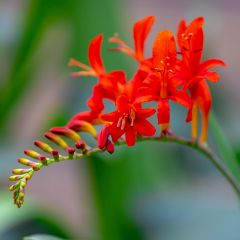
Crocosmia Lucifer - Montbretia
- Flowering time August to October
- Height at maturity 1 m
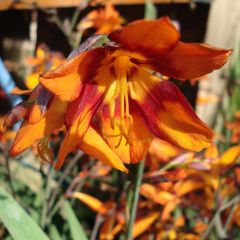
Crocosmia Emily McKenzie - Montbretia
- Flowering time August to October
- Height at maturity 60 cm
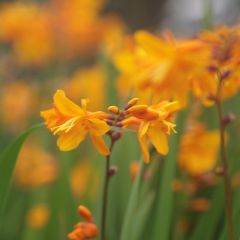
Crocosmia Columbus - Montbretia
- Flowering time August to October
- Height at maturity 50 cm
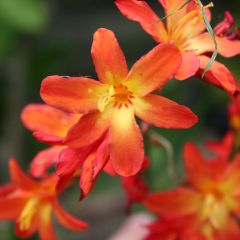
Crocosmia Carmine Brillant - Montbretia
- Flowering time August to October
- Height at maturity 70 cm
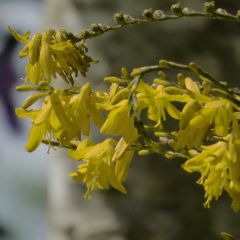
Crocosmia Solfatare - Montbretia
- Flowering time August, September
- Height at maturity 60 cm
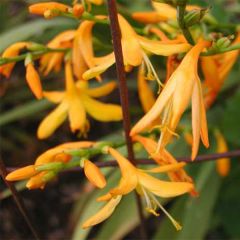
Crocosmia George Davison - Montbretia
- Flowering time August to October
- Height at maturity 45 cm
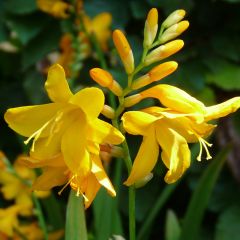
Crocosmia Buttercup - Montbretia
- Flowering time August to October
- Height at maturity 60 cm
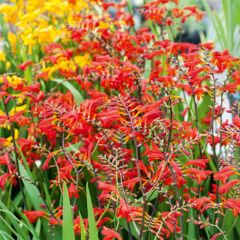
Crocosmia Emberglow - Montbretia
- Flowering time August to October
- Height at maturity 60 cm
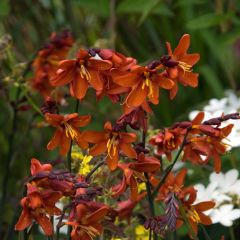
Crocosmia Dusky Maiden- Montbretia
- Flowering time February
- Height at maturity 40 cm
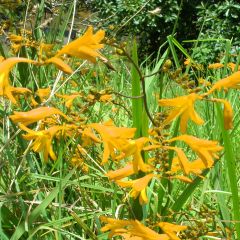
Crocosmia Norwich Canary - Montbretia
- Flowering time August to October
- Height at maturity 60 cm
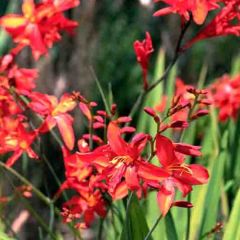
Crocosmia Zeal Tan - Montbretia
- Flowering time August, September
- Height at maturity 60 cm
These species exist in the wild, mainly in South Africa. They can be harder to source than horticultural varieties, except for Crocosmia masoniorum, which is fairly common in cultivation.
- Crocosmia masoniorum
With its bright orange flowers, this is undoubtedly the most beautiful of the botanical Crocosmia species. It reaches a height of 80 cm. Easy to grow, it is also hardier and more robust than other varieties, tolerating temperatures as low as –15°C. It is named after the American botanist Herbert Louis Mason (1896–1994). It originates from mountainous areas on the eastern coast of South Africa (Eastern Cape). Its distribution is quite limited, making it rare in the wild.
- Crocosmia paniculata
This species grows 1.20 m to 1.50 m tall and bears beautiful orange-red flowers, 6 cm long, on branched stems. Its leaves are strongly pleated and bright green.
- Crocosmia aurea
This species is common in the grasslands of the Cape Floristic Region in South Africa. It is found from South Africa to Sudan. It can reach 1.20 m in height. It blooms in branched inflorescences, each bearing up to ten large, bright orange flowers, 4 cm in diameter. Its lance-shaped leaves are 2 to 3 cm wide.
- Crocosmia pottsii
This species can grow 80 cm to 1 m tall. Its inflorescences bear up to 30 small orange flowers.
Discover other Crocosmia
Planting
Where to plant?
Crocosmia thrives in full sun, where it will flourish most readily. However, it can tolerate partial shade. Feel free to plant it at the base of a south-facing wall.
Crocosmia prefers slightly acidic soils but also grows very well in neutral soil.
It enjoys moist ground that doesn’t dry out in summer and will thrive if planted near a pond. Still, ensure the soil is well-drained with sand or gravel. It prefers aerated, light soils. To protect its corms from rotting, avoid waterlogging in winter!
You can also grow it in pots, either as a standalone feature or paired with perennials or ornamental grasses. Choose a sufficiently large container, add gravel at the base for drainage, and plant it in a mix of compost, garden soil and sand.
When to plant?
The ideal planting period is in spring, during April-May, once the risk of frost has passed.
How to plant?
Corms are planted in the same way as bulbs. Start by working the soil to a depth of 15-20 cm. As Crocosmia appreciates rich soils, you can add compost or fertiliser. To improve drainage, incorporate sand, especially if your soil is heavy or clay-based. Plant the bulbs 8-10 cm deep (or up to 15 cm in colder regions), ensuring the pointed end faces upwards. Space them 10 cm apart to allow enough room for growth. We recommend planting them in groups for a more striking display—cluster around ten corms together in the same flowerbed. Cover with soil and water generously.
→ Discover our tips for growing Crocosmia in pots
Read also
Planting CrocosmiasCare and maintenance
Once planted, Crocosmia requires very little maintenance. Indeed, it is undemanding and has no specific diseases or pests. Just ensure you keep the soil moist and protect it from the cold during winter, as Crocosmia is only moderately hardy.
The roots of Crocosmia allow it to burrow deeper into the soil over time, making it slightly more frost-resistant as the years go by! The first winter is therefore the most delicate to get through—don’t hesitate to protect the plant in one of the following ways:
- If temperatures do not drop below –5°C (or if you’ve chosen a hardy variety like Crocosmia masoniorum…), simply apply a thick layer of mulch made of dead leaves at the base. Additionally, in autumn, when the foliage has dried, we recommend leaving it in place to protect the crown during winter rather than cutting it back for aesthetic reasons.
- If you live in a region where deep cold persists throughout winter, it’s wise to dig up the bulbs in autumn to protect them from frost. Store them in a dry, dark, and well-ventilated place, away from moisture to prevent damage. Check them regularly, as they may be nibbled by rodents or rot due to dampness. You can replant them in spring once all risk of frost has passed.
Crocosmia detests summer drought: the soil must remain moist, even in peak summer. To prevent the soil from drying out too much and reduce watering, we recommend protecting it with a layer of mulch. In any case, if you’ve planted Crocosmia in a pot, regular watering is essential. We suggest watering every ten days during the growing season if the weather is dry.
To prolong flowering, we recommend regularly removing faded blooms. This will encourage new flowers to develop.
Propagation
Crocosmia is easy to propagate. It regularly produces new corms, which you can collect to obtain new plants. If you don’t cut back the faded flowers, Crocosmia will tend to self-seed. You can collect the seeds and sow them, but they won’t produce plants identical to the original variety. Moreover, growing from seed means waiting a long time before achieving a substantial clump. That’s why we recommend buying bulbs or dividing existing plants instead.
Sowing
In autumn, once the seeds are harvested, you can sow them in pots or trays under cover. The process is quite simple. Place the seeds in a tray filled with pre-moistened compost. Cover with soil. Crocosmia may take 3 to 8 weeks to germinate. Keep the compost moist until the plants sprout. In spring, once the risk of frost has passed, you can transplant them outdoors. However, it will take 2 to 3 years for the plants to flower.
Dividing corms
You can divide the corms in early spring, in March-April, before the plant starts growing. This can be done every three years to prevent overcrowding.
Crocosmia regularly produces stolons, from which new corms grow, stacked one above the other. Dig widely around the plant to avoid damaging the stolons and corms. Lift the clump and collect the new corms around the original plant. It’s best to leave each group of corms intact rather than separating them with a knife—the older ones will act as a nutrient reserve to support the growth of younger corms. Replant the new corm groups in a suitable location.
Conversely, if you want to control the spread of overly vigorous Crocosmia, separate the corms with a sharp knife. Preferably keep the younger ones, those on top. You can either discard the lower (older) corms or keep each one to maximise the number of plants. Replant and water well.
Association
With its vibrant and abundant flowering, the Crocosmia is a beautiful plant to include in an English-style mixed border. It will add an exotic touch to your flower beds. Pair it with other blooms in yellow-orange-red tones to create a highly colourful display! Rudbeckias, Gaillardas or Monardas will complement it perfectly! The red varieties are particularly suited to large gardens. They help draw the eye to a focal point in the garden and serve as a guide for visitors…
The slender leaves and airy blooms of the Crocosmia give it a graphic quality, allowing it to add volume to a flat or formally structured border. It can create a striking contrast when planted alongside more rigidly pruned plants. You could also pair it with white-flowering plants to soften the Crocosmia’s vivid colours.
For more planting inspiration, see our advice sheet: Crocosmia – 9 Successful Planting Combinations.
Useful resources
- Our wide range of Crocosmias
- Planting guide: How to plant Crocosmias
- Advice sheet: Mulching – Why and How?
- Our advice sheet: 8 orange-flowering summer bulbs you must have in your garden
- Also discover Chasmanthes!
- Discover the 6 most beautiful Crocosmia varieties, 5 orange Crocosmias
- Advice sheet: Small gardens and flowering pots: choose compact Crocosmias
- Advice sheet: Tall-flowered Crocosmias: our selection for a majestic garden
- Crocosmia flowers for a long time! Discover other bulbs in Adopt these long-flowering bulbs!
- Subscribe!
- Contents
